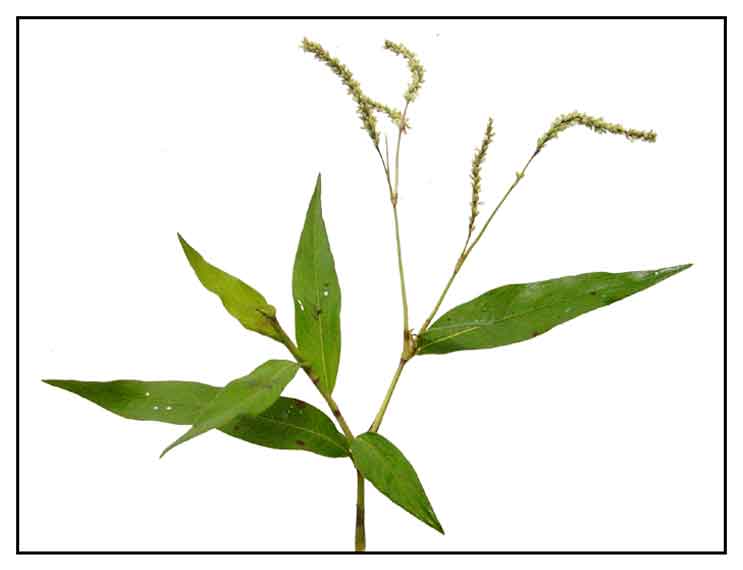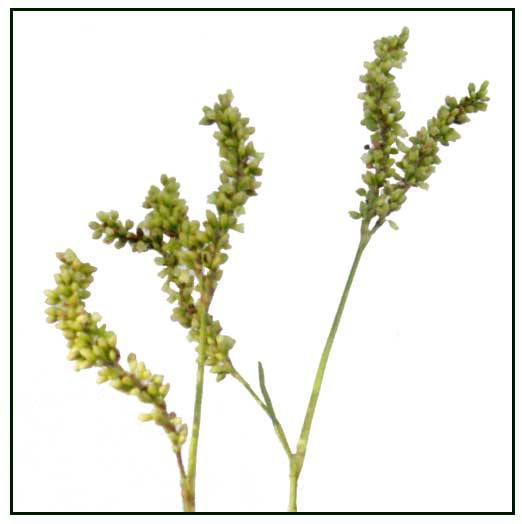 Gen info Gen info
- Persicaria is a genus of herbaceous flowering plants in the Knotweed family, Polygonaceae. Plants in the genus are commonly known as knotweeds or smartweeds. (24)
Botany
Subsuban is an ascending, slightly
hairy plant, growing to a height of 30 to 60 meters. Stipules are sheathing,
and cut into long, filiform cilia which are longer than the tube. Leaves
are lanceolate 10 to 15 centimeters long, smooth or nearly so except at the ciliate margins and midrib, and
tapering at both ends. Inflorescence is terminal, and in the upper axils,
sparingly branched, with erect, lax and peduncled racemes, 2 to 6 centimeters long, 5 to 7
millimeters in diameter. Flowers are in short, slender pedicels. Perianth is
white, greenish, or purplish, 2 millimeters long and without glands. Fruit is a triangular, black and shining
nut.
Distribution
- Native to the Philippines.
-
In open, usually wet places
at low and medium altitudes, up to 1,400 meters in some regions, throughout the Philippines.
- Also occurs in Africa, India, Malaya, Bangladesh, Thailand, and in many other countries in South-East Asia.
Constituents
- Study of aerial parts yielded sitosterone, viscozulenic acid, and acetophenone.
- Study isolated flavanones from chloroform and ethyl acetate extracts of leaves.
- Study of Polygonum barbatum var. barbata yielded sitosterone from a petroleum ether fraction, and viscozulenic acid and acetophenone from the chloroform fraction of methanol extract of aerial parts. (15)
- GC-MS analysis of P. barbatum hydroalcoholic leaf extract yielded 22 compounds, with terpenoids as the major constituents, along with carbohydrate and fatty acids.
(20)
- Phytochemical screening of whole plant yielded saponins, sterols, mucilage, glycosides, alkaloids, steroidal saponins in both alcoholic and aqueous extracts. (see study below) (21)
P roperties roperties
- Considered astringent, carminative, parasiticide.
- Root considered astringent and cooling.
- Studies have suggested anti-ulcer, wound healing, antimicrobial, analgesic, anti-inflammatory, antiulcer, antiproliferative properties.
 Parts used Parts used
Leaves, seeds, stems, and roots.
Uses
Edibility
- Young leaves and shoots cooked as vegetable.
Folkloric
- Sap of pounded leaves applied
to wounds is considered an effective cicatrizant.
- In Malabar seeds are used to relieve colic pains.
- Roots are used as astringent.
- In China decoction of leaves and stems used to wash wounds and ulcers.
- Sap applied to wounds as antiseptic.
- Paste of roots used for treatment of scabies.
- Seeds used for treatment of dysentery and cholera.
Studies
• Anti-Ulcer / Leaves / Whole Plant:
A study on the aqueous and methanolic leaf extracts of P barbatum showed
reduction of gastric volume, total acidity, free acidity and ulcer index.
The antiulcer activity may be due to the presence of flavanoids and
tannins. (1)
Study evaluated the antiulcer activity of a leaf extract on aspirin-and-pylorus ligation and aspirin-induced ulcer models. Results showed antiulcer activity with significant decrease in ulcer index, acidity, volume and increase in pH of gastric content. (6) Study of alcoholic and aqueous extracts of whole plant showed antiulcer activity with significant (p<0.01) reduction of ulcer score, ulcer number, ulcer index, free acidity, and total acidity in pylorus ligation, ethanol induced gastric mucosal damage ulcer models in rats. (see constituents above) (21)
• Wound-Healing: A study of wound
healing on albino rats of Wistar strain showed a significant increase
in wound closure rate, tensile strength and decrease in epithelization
period in PB treated group. Study concludes that ethanolic extract of
P B had greater wound healing activity than nitrofurazone ointment. (2)
• Phytochemical : Study of aerial parts yielded sitosterone, acetophenone, and viscozulenic acid. Acetophenone is used extensively as a food additive to create various food fragrances, and is also known to possess hypnotic and anticonvulsant property.
• Cholinergic / Spasmolytic / Brine Shrimp Toxicity / Aerial Parts: Study evaluated the cholinergic and spasmolytic activities of extracts of aerial parts of P. barbatum using rabbit jejunum. The dichlormethane extract showed dose dependent spasmolytic effect while a methanol extract showed dose-dependent cholinergic effect that was atropine sensitive. Spasmogenicity was without co-relaxant effect. The DME also showed marked brine shrimp toxicity. Antibacterial, antifungal, and larvicidal activities were absent. (7)
• Antimicrobial / Leaves: Study screened Polygonum barbatum for antimicrobial activity. An ethanolic leaf extract showed considerable broad spectrum activity against gram positive, gram negative and fungal organisms. (8) Study evaluated Polygonum barbatum for antimicrobial activity against Gram-positive (B. subtilis, M. luteus, S. aureus), Gram negative (S. setubal, P. picketti) and two fungal strains (A. fumigatus and A. flavus). Results showed significant antimicrobial activity. Among all fractions, n-hexane showed significant activity against S. setubal. The n-BuOH fraction showed activity against both fungal strains, Aspergillus fumigatus and A. flavus. (22)
• Wound Healing / Whole Plant: Study of whole plant extracts on two wound models (excision wound model and incision wound model) showed wound healing properties comparable with Providone iodine. The aqueous extract was found to be more effective. (9)
• Antioxidant: Study evaluated a leaf extract for in-vitro antioxidant activity. The PBLE contained a noticeable amount of total phenols. Results showed concentration-dependent antioxidant activity. An ethanolic extract showed significant antioxidant activity and a better source of natural antioxidants. (10) Study evaluated the in vitro antioxidant activity of P. barbatum extract by SPPH, NO, SO scavenging assays. DPPH radical scavenging assay yielded an IC50 of 32.62 µg/mL, higher than other methods. (19)
• Antinociceptive / Anti-Inflammatory / Diuretic: Study evaluated the antinociceptive, anti-inflammatory and diuretic properties of extracts of P. barbatum (L.) Hara var. barbata in mice/rat models. Results showed dose dependent analgesic effect in acetic acid induced writhing test in mice. Petroleum ether extract showed highest anti-inflammatory activity using carrageen-induced edema test. An ethyl acetate extract showed significant diuretic effect comparable to standard agent furosemide. (14)
• Herb-Drug Interaction / Moderate Interaction with Warfarin: The plant contains large amounts of vitamin K which helps blood clotting. Warfarin is used to slow blood clotting. Therefore, subsuban might decrease the effectiveness of warfarin (coumadin). (16)
• Antiproliferative Sesquiterpenes / Apoptotic Pathway / Aerial Parts: Study evaluated three new sesquiterpenes isolated from an ethyl acetate fraction of aerial parts of Polygonum barbatum for anti-cancer potential against different cancer cell lines: non-small cell lung carcinoma (NCI-H460), breast cancer (MCF-7), cervical cancer (HeLa) and normal mouse fibroblast (NIH-3 T3) cell lines. Compound 3 showed more cytotoxicity against NCI-H460 and MCF-7 cells with IC50s of 17.86 ± 0.72 and 11.86 ± 0.46 µM, respectively. Compound 3 showed potent antiproliferative potential as well as induced apoptosis and inhibited cell migration of cancerous cells by altering gene expression and inhibited angiogenesis. (17)
• Gastroprotective / Antioxidant / Leaves:Study evaluated the antiulcer and antioxidant activity of ethanolic leaf extract of Pl barbatum against cold restraint stress induced ulcer in rats. Results showed both doses of the leaf extract, 250 and 500 mg/kg, significantly reduced the ulcer index and protected the animals against stress-induced free radical damage as evidenced by decrease in LPO and reversal of changes induced by stress on SOD and CAT. The gastroprotective activity was attributed to its antioxidant property. (18)
• Optimization of Antioxidant Extraction / Leaves: Study reports on the optimization of antioxidant capacity from Persicaria barbata leaf extract using response surface methodology (RSM). The order of factors influencing the response value of antioxidant capacity was ethanol concentration, extraction time, and liquid-to-solid ratio, respectively., The ascorbic acid equivalent antioxidant capacity (AEAC) value equivalent was 93.925 mg AEAC/g of dried plant. . (23)
Availability
Wildcrafted.
|



